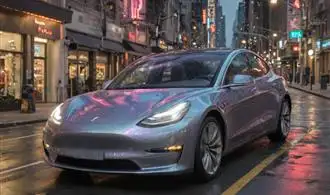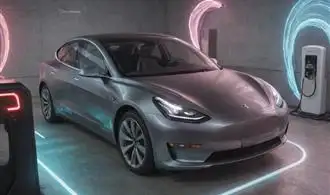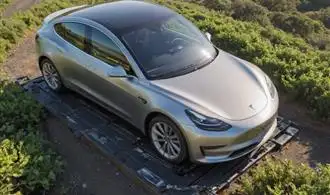
Understand Your Tesla Model 3s Charging Capabilities
The Tesla Model 3 is known for its impressive range and efficient charging capabilities. Understanding the charging capabilities of your Model 3 is crucial to ensuring you get the most out of your vehicle. The Tesla Model 3 can be charged using a variety of methods, including Level 1, Level 2, and DC fast charging.
Level 1 charging, which uses a standard 120V household outlet, is the slowest charging method, providing around 3-5 miles of range per hour of charging. This is a convenient option for overnight charging, but it may not be sufficient for daily commuting or long-distance travel.
Level 2 charging, which uses a 240V outlet, is the more common and preferred charging method for Tesla Model 3 owners. This charging method can provide up to 30 miles of range per hour of charging, making it a much more efficient option for daily use. Many Tesla owners install a Level 2 charging station in their homes or workplaces to take advantage of this faster charging speed.
DC fast charging, also known as Supercharging, is the fastest charging method for the Tesla Model 3. This method uses a high-powered charging station to provide up to 175 miles of range in as little as 15 minutes. Tesla's Supercharger network is one of the most extensive fast-charging networks in the world, making it easy for Tesla owners to charge their vehicles during long-distance travel.
It's important to note that the actual charging speed and range added per hour of charging will depend on various factors, such as the battery's state of charge, ambient temperature, and the charging station's output. Additionally, Tesla Model 3 owners can take advantage of the vehicle's regenerative braking feature, which can add up to 5 miles of range per minute of driving in certain conditions.
Selecting the Right Charging Solution for Your Needs
Choosing the right charging solution for your Tesla Model 3 can be a critical decision that impacts your driving experience and convenience. The type of charger you select will depend on several factors, including your driving habits, charging needs, and the infrastructure available in your area. Let's explore the different charging options to help you make an informed choice.
Level 1 Charging: This is the most basic charging option, utilizing a standard household outlet. While convenient, Level 1 charging is relatively slow, adding only about 3 to 5 miles of range per hour of charging. This solution may be suitable for those with shorter commutes or who can leave their car plugged in overnight.
Level 2 Charging: This is the most common and recommended charging solution for Tesla Model 3 owners. Level 2 chargers can be installed at your home or workplace, providing a significant boost in charging speed. These chargers typically add 10 to 25 miles of range per hour, making them a game-changer for daily driving and longer trips. Consider factors like your home's electrical capacity, installation costs, and the availability of Level 2 charging stations in your area when choosing this option.
Supercharging: Tesla's proprietary Supercharger network offers the fastest charging solution for your Model 3. These high-powered charging stations can add up to 200 miles of range in just 15 minutes, making them ideal for long-distance travel. While Superchargers are conveniently located along major highways and in urban areas, they may not be as readily available in some regions. Understanding the Supercharger network coverage in your area can help determine if this is the best charging option for your needs.
Mobile Connector: Tesla provides a mobile connector, a versatile charging solution that can be used with a variety of outlets, including Level 1 and Level 2 charging. This portable charger offers flexibility, allowing you to charge your Model 3 at home, work, or even while traveling. The mobile connector can be a valuable backup option, but keep in mind that its charging speed may be slower than a dedicated Level 2 charger.
Mastering Level 1 Charging for Everyday Use
Level 1 charging, the most basic charging option for your Tesla Model 3, is an often-overlooked but essential part of owning an electric vehicle. While it may not be the fastest charging method, it can be an incredibly convenient and cost-effective way to keep your car powered up for daily commutes and local trips. The key to making the most of Level 1 charging is understanding its capabilities, limitations, and how to optimize it for your specific needs.
One of the primary benefits of Level 1 charging is its simplicity. All you need is a standard 120-volt household outlet, and you can plug in your Tesla's mobile connector and start charging. This means you can charge your car anywhere you have access to a power outlet, whether it's at home, work, or even a friend's house. This flexibility can be particularly useful for Tesla owners who don't have the ability to install a dedicated Level 2 charging station.
However, the trade-off for this convenience is the slower charging speed. Level 1 charging typically provides around 3 to 5 miles of range per hour of charging, which can be significantly slower than the 10 to 20 miles per hour offered by a Level 2 charger. This means that if you're relying solely on Level 1 charging, you may need to plan your charging schedule more carefully to ensure your Tesla is always ready for your daily driving needs.
To maximize the efficiency of your Level 1 charging, it's important to understand your daily driving habits and adjust your charging routine accordingly. For example, if you have a short commute and your Tesla is parked at home for the majority of the day, you may be able to rely on Level 1 charging to keep your battery topped up. On the other hand, if you have a longer commute or frequently take longer trips, you may need to supplement your Level 1 charging with occasional fast charging sessions or the installation of a dedicated Level 2 charger at home.
Another key consideration when using Level 1 charging is the impact on your Tesla's battery health. While Level 1 charging is generally gentler on the battery than faster charging methods, it's still important to monitor your battery usage and charge levels to ensure you're not overcharging or undercharging your Tesla. The 20 Shocking Things You Didn't Know About Tesla Model 3 Efficiency can provide valuable insights into optimizing your battery management.
Unlocking the Power of Level 2 Charging for Faster Refueling
As a Tesla Model 3 owner, you understand the importance of keeping your vehicle charged and ready for your daily commute or road trips. While the standard Level 1 charging can get the job done, unlocking the power of Level 2 charging can significantly enhance your refueling experience. Level 2 charging, also known as "240V" or "L2" charging, offers a faster and more efficient way to charge your Tesla Model 3, allowing you to maximize your time and minimize downtime.
One of the primary benefits of Level 2 charging is the significantly reduced charging time. Depending on the specific model and battery capacity of your Tesla Model 3, Level 2 charging can replenish your battery at a rate of 10-30 miles of range per hour, compared to the typical 3-5 miles per hour with a standard Level 1 charger. This means you can charge your vehicle more quickly, making it ready for your next adventure in a fraction of the time.
To take advantage of Level 2 charging, you'll need to have a dedicated 240V electrical outlet installed in your home or workplace. This may require the assistance of a licensed electrician, who can ensure the proper wiring and electrical infrastructure are in place to support the higher power requirements of a Level 2 charger. While the initial installation cost may be higher than a Level 1 setup, the long-term benefits of faster charging and enhanced convenience can make it a worthwhile investment.
When selecting a Level 2 charger for your Tesla Model 3, consider factors such as charging speed, compatibility with your vehicle, and portability. Many Level 2 chargers are wall-mounted, providing a permanent solution, while others are portable and can be easily transported to different locations. Regardless of the type, ensure the charger is rated for the specific power output and amperage required by your Tesla Model 3.
In addition to the hardware, it's essential to understand the charging habits and techniques that can maximize the efficiency of your Level 2 charging experience. Some best practices include:
- Scheduling your charging sessions during off-peak hours, when electricity rates are typically lower, to optimize your energy costs.
- Monitoring your charging progress and adjusting your schedule accordingly to avoid unnecessary overcharging.
- Keeping your Tesla Model 3's charging port and the charger's connector clean and free of debris to maintain optimal connection and efficiency.
- Considering the installation of a smart home energy management system, which can integrate with your Tesla Model 3 and Level 2 charger to optimize your charging routines and energy usage.
Navigating the Convenience of Tesla Superchargers
Tesla's Supercharger network is a game-changer in the world of electric vehicle charging. As a Tesla Model 3 owner, you have access to this extensive network, allowing you to charge your vehicle quickly and conveniently. Understanding how to leverage the Supercharger network is crucial for maximizing the efficiency and convenience of your driving experience.
One of the primary benefits of the Tesla Supercharger is its speed. These charging stations are designed to deliver up to 250 kW of power, enabling your Model 3 to regain a significant amount of charge in a relatively short period. Depending on the specific model and battery capacity, a Tesla Model 3 can typically add 150 to 200 miles of range in just 15 to 20 minutes of Supercharging.
To ensure a seamless Supercharging experience, it's essential to plan your journey and locate the nearest Supercharger stations along your route. The Tesla mobile app and in-vehicle navigation system provide real-time information on Supercharger availability, allowing you to identify the most convenient charging stations and plan your stops accordingly.
When using a Supercharger, it's important to note that the charging rate may vary based on several factors, including the current state of charge, battery temperature, and the number of vehicles sharing the Supercharger. Understanding these variables can help you manage your charging time and expectations, ensuring you make the most of your Supercharging sessions.
Additionally, Tesla Superchargers are designed to be user-friendly, with intuitive interfaces and straightforward charging processes. Simply plug in your Model 3, and the charging session will begin automatically, allowing you to relax or attend to other matters while your vehicle regains its charge.
- Plan your route in advance and identify the Supercharger locations along the way to minimize unplanned stops.
- Monitor your battery level and charge accordingly, avoiding letting your battery drain to low levels before seeking a Supercharger.
- Be mindful of peak usage times and, if possible, try to charge during off-peak hours to avoid congestion at the Supercharger stations.
- Familiarize yourself with the Tesla mobile app and in-vehicle navigation system to stay up-to-date on Supercharger availability and plan your charging stops effectively.
- Ensure your Tesla Model 3 is equipped with the latest software updates to benefit from any improvements or enhancements to the Supercharging experience.
















